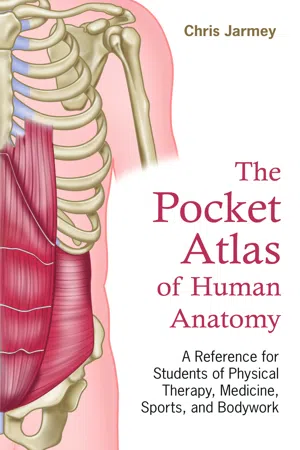
The Pocket Atlas of Human Anatomy
A Reference for Students of Physical Therapy, Medicine, Sports, and Bodywork
- English
- ePUB (mobile friendly)
- Available on iOS & Android
The Pocket Atlas of Human Anatomy
A Reference for Students of Physical Therapy, Medicine, Sports, and Bodywork
About this book
The Pocket Atlas of Human Anatomy has been produced as an aide-mémoire for the student and early practitioner of anatomy, physical therapy, chiropractic, medicine, physiotherapy, or any other health-related field. Containing full-color illustrations, the book is a compact reference guide, detailing anatomical terms, tissues, bones, axial and appendicular skeletons, joints, and the musculoskeletal system. A final chapter by Thomas Myers outlines The Anatomy Trains myofascial meridians which presents a map of how tracks of fascial fabric wind longitudinally through series of muscles. This new approach to structural patterning has far-reaching implications for effective movement training and manual therapy treatment. Two appendices illustrate the major neural pathways (Appendix 1) and the major skeletal muscles (Appendix 2), including the origin, insertion, and innervation for each muscle, plus detailed charts of the main muscles involved in movement.
Frequently asked questions
- Essential is ideal for learners and professionals who enjoy exploring a wide range of subjects. Access the Essential Library with 800,000+ trusted titles and best-sellers across business, personal growth, and the humanities. Includes unlimited reading time and Standard Read Aloud voice.
- Complete: Perfect for advanced learners and researchers needing full, unrestricted access. Unlock 1.4M+ books across hundreds of subjects, including academic and specialized titles. The Complete Plan also includes advanced features like Premium Read Aloud and Research Assistant.
Please note we cannot support devices running on iOS 13 and Android 7 or earlier. Learn more about using the app.
Information














Table of contents
- Cover
- Half Title
- Full Title
- Copyright
- Contents
- Foreword
- A Note About Peripheral Nerve Supply
- 1 - Anatomical Terms
- 2 - Tissues
- 3 - Bones
- 4 - The Axial Skeleton
- 5 - The Appendicular Skeleton
- 6 - Joints
- 7 - The Musculoskeletal System
- 8 - Fascia and the Anatomy Trains Myofascial Meridians
- Appendix 1: Muscle Innervation Pathways
- Appendix 2: Muscles Involved in Movement
- Resources
- Index